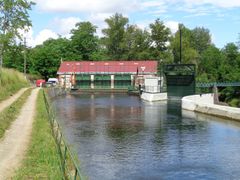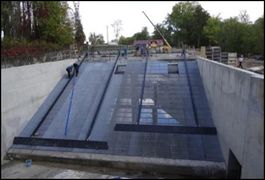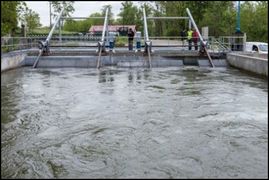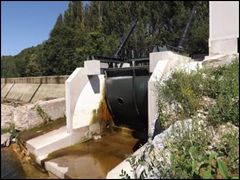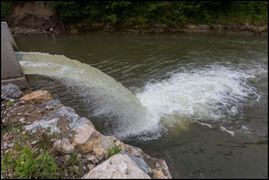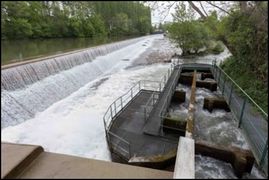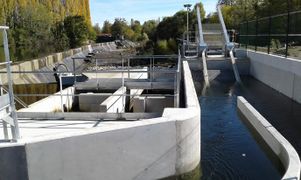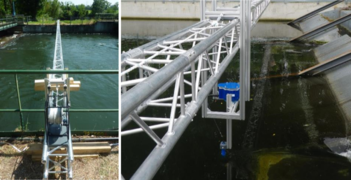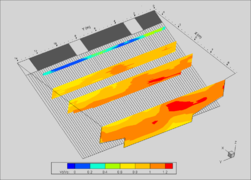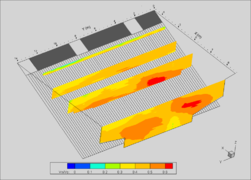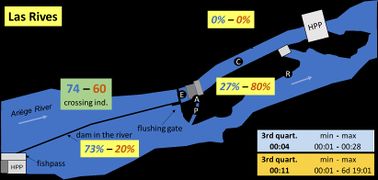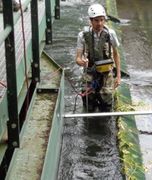Las Rives test case
| Fact box: Las Rives | |
|---|---|
| Country | France |
| River | Ariège |
| Operator | ONDULIA |
| Capacity | 2.7 MW |
| Head | max. 6 m |
| Inter-annual discharge | 41.8 m3/s |
| Turbine(s) | 3 Francis turbines |
| Detailed report | Click for pdf |
Contents
Introduction
The Test Case is located on the river Ariège in the South of France, between Crampagna and Varilhes. The dam of Labarre at the upstream part of the water body constitutes a block to upstream migration and participates to the regulation of flows with its reservoir of 400 000 m3 (17.6 ha).
The hydrology of the Ariège is characterized by a sustained flows in winter, high water levels in spring due to snow melting and low water period from August to October. During the downstream migration period of smolts (March, April, May) the mean monthly discharges range from 41.3 m3/s in March to 79.1 m3/s in May.
The hydropower plant of Las Rives is part of a section of 20 km with 5 hydropower plants. Altogether, there are 7 further HPPs are located upstream and downstream of the Test Case.
About the hydropower plant
The HPP of Las Rives is downstream the station of Foix. It has an installed capacity of 2.7 MW and a mean inter-annual discharge of about 41.8 m3/s. There are several creeks and one watercourse flowing into the Ariège before the HPP Las Rives.
Layout
The HPP of Las Rives is an run-off-river HPP which bypass reach is 580 meters long.
The Operator: ONDULIA
ONDULIA is a green energy producer. It owns 10 hydropower plants, 8 wind farms and one photovoltaic roof. This represents an installed capacity of 77MW thanks to 64 turbines. The mean annual production of their installations is around 180 million kWh, corresponding to the consumption of a city of 70 000 inhabitants. Read more.
Test case topics
Downstream migration
To protect the fish on their downstream migration, the rack in front of the hydropower plant was changed in 2014. Its location was changed from the power plant to the head of the headrace channel. The bar screen with a length of 14m is now located in the head of the headrace channel on the left bank, allowing the integration of the downstream migration flow into the instream flow. There are 3 downstream migration outlets at the top of the bar screen and migration duct, which sections increase with closeness to the downstream migration channel. At the outlet of the downstream migration channel the fish fall from a height of 3.4m into 63 cm of water when the total discharge of the river is smaller than 48.5 m3/s. This low water depth poses question about the conditions of landing of fishes in the pool. An experiment will start in spring 2018 to evaluate the effect of the fall on fishes.
Upstream migration
An alternate vertical slot pass is located at the upstream angle of the water intake weir (point of higher rising, right bank). The flow in the fishpass is 0.5 m3/s. 2.75 m3/s of complementary attraction flow are turbined by a new DIVE turbine (2017) at the right bank of the fishpass associated to a fish-friendly bar screen.
E-flow
In France, the law of 2006 (LEMA) imposes an e-flow of 1/10 of the mean inter-annual discharge before 1rst January 2014. For the environmental flow in the bypass section a minimum value equal to a tenth of the mean inter-annual discharge of the water course is chosen, which is 4.35 m3/s at Las Rives. In 2001, the E-flow was about 5 m3/s, and thereby greater than the minimum value.
In Las Rives, the operator found a compromise with the authorities to improve downstream migration conditions of fishes by the replacement of the former rack with a more efficient fish friendly trash rack and in return they installed a Dive turbine in order to use a part of the instream flow (2.75 m3/s of the attraction flow of the fish ladder). The operator increased its production and decreased the global mortality rate of the HPP. The replacement of the rack led to higher head losses.
Pressures on the water body's ecosystem
Due to 7 hydropower plants located on the Ariège the continuity of the water body is highly affected. Agricultural practices, with their use of pesticides, also have a significant effect on the river. The Ariège is a low water replenishment for the river Garonne. While there is a water storage upstream of this water body, the upstream hydropeaking management does influence the Ariège’s flow, leaving it with a moderate hydrology and morphology.
Research objectives and tasks
At Las Rives the ways for a fish friendly water intake and reception pool are being investigated. For this, the efficiency of the fish friendly water intake is tested and a hydraulic model is done to determine the attractiveness of the bypass. Different shapes of outlets are tested. The effect of consecutive hydropower plants on downstream migration delay of fishes is assessed.
Research tasks
The research tasks and field studies conducted at Las Rives are:
- Assessment of the efficiency of a fishfriendly water intake by fish tracking
- Hydraulic measurement in front of the inclined bar rack
- Hydraulic modelling of the water intake
- Studying the hydraulic conditions at the end of the downstream migration duct
- Scenario modelling of several downstream migration measures
Results
The Las Rives test case is a medium HPP with a fish friendly water intake in which is tested an inclined bar rack with several technical solutions. The efficiency of the inclined low bar spacing trashrack has been validated by radio telemetry for smolts (81% of efficiency) and eels (100% of efficiency). No cumulative effect on different successive HPPs has been shown during these tests. Depending on the river discharge, the fishes use bypasses as well as the overspill weir. ADCP measurements have been conducted at four cross-sections for different flow discharges, that show well-predicted normal and tangential components of the upstream velocity. This has also been validated by 3D modelling highlighting the attractiveness of the three bypasses, and confirmed by bypass discharge measurements. The landing conditions of the fishes at the foot of the control weir ending the downstream migration duct has also been studied and showed some fish damages (about 30%) which should bring on some modification of the landing zone. Finally, scenario modeling is proposed to see the cost effective solutions for the downstream migration on this site and promote the retained solution. Seven scenario have been compared for the downstream migration and were first analyzed and compared regarding monitoring and production calculation and then implement in a probabilistic network to assess the trade-off between downstream migration efficiency, productivity, and costs of the infrastructures for each scenario.
References
- Tomanova S, Courret D, Mercier O, Richard S, De-Oliveira E, Mataix V, Lagarrigue T, Frey A, Tetard S. 2019. Efficiency of downstream passage devices to protect migrating silver eels assessed with radiotelemetry. 5th International Conference on Fish Telemetry, Arendal, Norway, 2019, June 24th-28th., 2019.
- Lemkecher F, David L, Courret D, and Chatellier C, 2018. Field measurements of the attractivity of bypasses for fishfriendly trashrack. Riverflow 2018, 5/8 septembre, Lyon. https://doi.org/10.1051/e3sconf/20184003039
